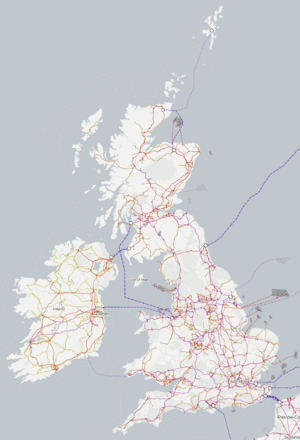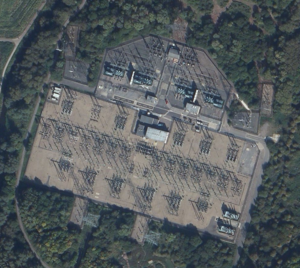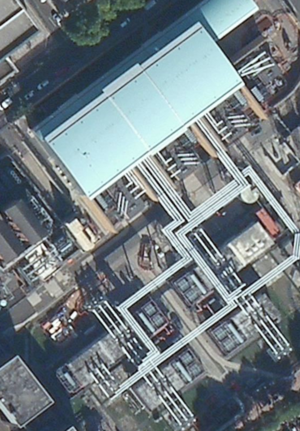Power networks/Great Britain
This page describes the power network in Great Britain but not the island of Ireland (which has a separate, integrated power grid across Northern Ireland and the Republic of Ireland). It's intended as a guide to accurately mapping the power network from aerial photos and by eye.
You can find a specialised map of power infrastructure in OSM on Open Infrastructure Map.
Please note: Most data available on the internet on power networks in the UK is not suitable for inclusion in OSM due to licensing incompatibilities. Please see the Data Sources section for more information.
Organisation

The electricity network in Great Britain is split into two sections:
The transmission network consists of 400 kV, 275 kV, and a few 220 kV power lines, and their associated substations. It's run by National Grid in England, and Scottish Hydro and Scottish Power in Scotland (the "Transmission Owners"). It includes the various interconnector cables which import and export power from Ireland, France, Belgium, the Netherlands, and Norway using high voltage DC - these are owned by independent companies. It also includes the cables linking major offshore wind farms to the grid, which are owned by "Offshore Transmission Owners".
In Scotland, the 132 kV lines are part of the transmission network. In England and Wales, they are part of the distribution network.
The regional distribution networks distribute electricity from the National Grid to homes and businesses. There are 14 distribution network areas, currently operated by six different companies (Electricity North West, Northern Powergrid, Scottish and Southern Energy, ScottishPower Energy Networks, UK Power Networks, and National Grid Electricity Distribution), referred to as Distribution Network Operators or DNOs.
As of 2022, National Grid Plc serves several functions in the UK's electricity network:
- National Grid Electricity Transmission is responsible for maintaining the transmission network in England.
- National Grid ESO (Electricity Supply Operator) is responsible for managing the transmission network and balancing supply and demand across Great Britain.
- National Grid Electricity Distribution is a distribution network operator in the Midlands, the South West, and South Wales.
Power Lines
| Network | Voltage | Notes | Appearance |
|---|---|---|---|
| Transmission | 400 kV | The National Grid. The vast majority, if not all, of these power lines are already mapped in Great Britain from NPE or OS.
220kV is only used for undersea wind farm interconnectors and the Kintyre-Hunterston link in Scotland. |
Large, tall pylons, normally carrying two circuits (6 cables), interconnecting large, prominent substations. |
| 275 kV | |||
| 220 kV | |||
| Transmission (Scotland)
Distribution (England & Wales) |
132 kV | The voltage which National Grid supplies to distribution networks. Also the voltage at which some larger onshore wind and solar farms supply their power to the distribution network. | Smaller pylons with 6 cables.
Sometimes tall "trident"-shaped wooden poles with 3 cables. |
| Distribution | 66 kV | Mostly used to supply substations in sparsely-populated rural areas and in large cities.
This voltage is used in the Northern Powergrid and National Grid Electricity Distribution (South Wales and West Midlands) distribution network areas, and also (entirely underground) in parts of London. |
Fairly tall, obvious poles with 3 cables. Occasionally small pylons with 6 cables, often interspersed with larger poles.
Few, if any, lines branching off. Cables are clearly visible in good aerial photos at certain angles. If a line goes between substations (and it's not a higher voltage), it's very likely to be 33 or 66 kV. |
| 33 kV | The most common intermediate distribution voltage. Most 132 kV substations output 33 kV. Smaller wind and solar plants often connect to the distribution network at 33 kV. | ||
| 25 kV | Used for overhead railway electrification only. If a power line doesn't go to a railway traction substation, it's not 25 kV. | ||
| 22 kV | A final-level distribution voltage which will probably supply your small local substation before being stepped down to 400 V. Distribution networks call these voltages "HV".
11 kV is by far the most common. 22 kV is only used in London, entirely with underground cables. 20 kV is (I think) only used in the North West. 6.6 kV is sometimes used in large cities. |
Smaller poles. Multiple cables may not be obvious from aerial photography.
Often a web of lines with many branches, fed from a single substation. Pole-mounted transformers (transformer=distribution) are often seen on these lines in rural areas. | |
| 20 kV | |||
| 11 kV | |||
| 6.6 kV | |||
| 400 V | Standard mains voltage for direct distribution to domestic and small industrial customers (400V phase-to-phase is 230V phase-to-neutral). Also known as "LV". | Normally very hard to spot on aerial imagery. |
If you see a power line tagged with a voltage which isn't in the above table, it's likely to be wrong. (But some offshore wind farms use unusual voltages - most often 150 kV and 220 kV - for their "export" cables.)
In the vast majority of cases, if a power line has three wires, it's a single three-phase circuit (cables=3). If it has six wires, it's two separate circuits (cables=6). The thin ground wire often found at the top of pylons is not included in the number of cables.
Power lines at 33 kV and above are often run in pairs (either two lines running side-by-side, or as two circuits on the same set of poles/towers), or as a ring around several substations, to provide redundancy in case of the failure of one line. 11 kV and similar distribution voltages are frequently an interconnected "web" and they may join multiple substations, but they are only usually fed from one at a time.
Power Line References
Power lines at 33 kV and above have short (2-4 character) alphanumeric reference numbers, such as "4VF". Poles/pylons along these routes are then numbered "4VF-1" etc. These are sometimes surveyable on the poles themselves, and can be added to the ref=* tag on the pole/pylon and the line.
Subsea Cables
Subsea power distribution cables are common around the UK, especially in the Scottish islands. These are usually at 33 kV, though a few 132 kV and 11 kV cables exist. They can sometimes be identified from aerial photos when a reasonably large power line stops dead right by the sea. You'll usually see a diamond-shaped cable marker on the shore, and if you're very lucky this too can be spotted on the aerial photography.
Substations
Substations should be tagged as power=substation. If a substation is connected to the National Grid (i.e. its maximum voltage is 275kV or 400kV), it should be tagged as substation=transmission. Otherwise, it should be substation=distribution, to keep the usage of these tags in line with the standard terminology used in Great Britain.
The name=* tag should contain the name of the substation, if known, such as "Waltham Cross Substation". It shouldn't contain the voltage, reference, or any other information - use other tags for that. As always, if you don't know the name, there shouldn't be a name tag.
Voltages
The voltage=* tag should be used to denote the voltages used in the substation, in volts, with multiple voltages separated by semicolons. For transmission and larger distribution substations, the maximum voltage used should be easy to see from connecting power lines, but it may not be possible to tag the voltage of every substation.
Voltage can be inferred from aerial photos by the appearance of power lines and the spacing of busbars, and it's possible to pick up a bit of a knack for this. If a substation has visible busbars or power bays, it's unlikely to be less than 33kV.
Transmission
Transmission substations will have a maximum voltage of 400kV or 275kV. Most, but not all, transmission substations are also grid supply points (GSPs), which is where the transmission voltage is stepped down by large transformers (sometimes known as SGTs or Super Grid Transformers) to 132kV for handoff to the distribution network.
These substations should be tagged with operator=National Grid Electricity Transmission PLC in England, and the appropriate operator in Scotland.
Traditional transmission substations, such as Waltham Cross, are very obvious from the large network of air-insulated busbars and switches.
More modern transmission substations may use Gas Insulated Switchgear (GIS) for part or all of their switchgear, especially if they're space-constrained. This looks quite different from the old air-insulated switchgear, and most of it is enclosed within buildings connected with gas-insulated transmission lines which look like white tubes. These buildings can be tagged with power=switchgear, gas_insulated=yes.
Some transmission substations also share a site with a distribution substation, which is frequently referred to by the same name. These are administratively and technically separate entities, run by different operators. The easiest way to tag these, unless you're sure what you're doing, is as a single site with all voltages in the voltage=* tag.
Distribution
Once power is handed over to the distribution network from the National Grid, it will probably pass through several substations before reaching your home.
Generally, the 132kV will be stepped down to 33 kV (sometimes 66 kV) for the first intermediate stage of distribution. These substations are sometimes referred to as grid substations or bulk supply points (BSPs). A rural 132 kV substation can service a radius of several hundred kilometres, while London's West End has three 132kV substations within 5 minutes' walk of each other, fed by underground tunnels.
Closer to the consumer, the voltage will then be stepped down to 11 kV or 6.6 kV at a primary substation for the next stage of distribution. In most areas, primary substations are reasonably-sized substations, but in very rural areas, they can be pole-mounted transformers. It's usually reasonable to assume that if a line does not terminate at a visible, fenced-off substation, it's 11 kV or below.
Finally, a secondary substation (sometimes just a transformer on a pole) will drop it down to 230V for domestic consumption.
Industrial customers may be fed power at 11kV, or occasionally at even higher voltages. In this case they will have their own substation, which should be tagged as substation=industrial.
Grid substations and some primary substations are generally fairly obvious on aerial imagery. Secondary substations are much less obvious and will need local knowledge to map.
It's common for multiple levels of substation to be located on the same site - so a 132kV substation might have a primary substation as well. It will output 33kV to send to other primary substations as well as 11kV for more local use. These are logically separate substations to the distribution network operator, they will often be physically separated on site, and may have separate entrances. However, it's not really worth tagging these differently, and voltage=132000;33000;11000 is acceptable here.
Islands
A small number of places have a power network which is not interconnected with the main GB power grid - these are islands, in both the technical and the geographical sense. In some cases these islands have a privately-operated power network which may not follow the same standards (e.g. voltages) as the rest of the GB power network. The general rules mentioned above may not apply.
Many of these islands had their electrical grids installed or substantially modernised in the 2000s/2010s, following the example of the Isle of Eigg.
|
Network Operator | Distribution Voltage | Approximate Power Demand | Notes |
|---|---|---|---|---|
| Shetland | Scottish & Southern Electricity Networks | 33 kV / 11 kV | 150 MW | Shetland has a fairly large power grid, with two major fossil fuel plants and a significant amount of wind power. It is currently not connected to the GB grid, but a HVDC link from the mainland is now under construction in order to facilitate the export of wind power. |
| Eigg | Eigg Electric | Unknown | 150 kW | Community-owned electricity company, powered by wind, solar, and hydro with battery storage and diesel backup. Electricity network is underground.[1][2] |
| Muck | Isle of Muck Power | 3.3 kV | 50 kW | Wind and solar with battery storage and diesel backup.[3] |
| Rùm | Isle of Rum Community Trust | 25 kW | Hydro with battery storage and diesel backup.[4] | |
| Canna and Sanday | Canna Renewable Energy and Electrification | Unknown | 50 kW | Wind and solar with battery storage and diesel backup.[5] |
| Fair Isle | Fair Isle Electricity Company | 3.3 kV | 50 kW | Wind and solar with battery storage and diesel backup.[6] |
| Foula | Foula Electricity Trust | 3.3 kV | 25 kW | Wind, solar, hydro with battery storage and diesel backup.[7] |
Data Sources
There is a reasonable amount of data on the UK's power networks available on the internet, however most of this is not under an open license and hence must not be used to map in OSM.
| Operator | License | Suitable for OSM | Notes |
|---|---|---|---|
| National Grid Electricity Transmission | Custom, very restrictive license | No | Vast majority mapped from other sources. |
| SSEN Transmission | CC-BY 4.0 | No | License waiver required. Majority should be mapped from other sources. |
| National Grid Electricity Distribution | "NGED Shared Data Licence" | No. | Data published before July 2024 was available as an OGLv3 clone, however has now reverted to a non-open license. |
| UK Power Networks | CC-BY 4.0 | No | License waiver required. They refuse to provide one despite significant attempts. |
| Electricity North West | CC-BY 4.0 | No | License waiver required, requested by Russss (talk) (11/2023), reply not received. |
| Northern Powergrid | Northern Powergrid Open Data Licence v1.0 | No | License is an OGLv3 clone. Attribution clarification required, requested by Russss (talk) (11/2023), reply not received. |
| Scottish & Southern Electricity Networks | CC-BY 4.0 | No | License waiver required, requested by Russss (talk) (11/2023), reply not received. |
| SP Energy Networks | CC-BY 4.0 | No | License waiver required. Data was previously briefly available under a different license. |
An overlay of this data which is suitable for use in OSM editors is available at gb-power.russss.dev.
References
- ↑ http://www.windandsun.co.uk/case-studies/islands-mini-grids/isle-of-eigg,-inner-hebrides,-scotland.aspx
- ↑ http://isleofeigg.org/eigg-electric/
- ↑ http://www.windandsun.co.uk/case-studies/islands-mini-grids/isle-of-muck.aspx
- ↑ http://www.windandsun.co.uk/case-studies/islands-mini-grids/isle-of-rum.aspx
- ↑ http://www.windandsun.co.uk/case-studies/islands-mini-grids/isle-of-canna.aspx
- ↑ http://www.windandsun.co.uk/case-studies/islands-mini-grids/fair-isle.aspx
- ↑ http://www.windandsun.co.uk/case-studies/islands-mini-grids/isle-of-foula,-shetland-isles.aspx


